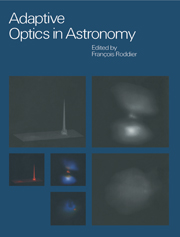Book contents
- Frontmatter
- Contents
- List of contributors
- Part one Introductory background
- Part two The design of an adaptive optics system
- 3 Theoretical aspects
- 4 Wave-front compensation devices
- 5 Wave-front sensors
- 6 Control techniques
- 7 Performance estimation and system modeling
- Part three Adaptive optics with natural guide stars
- Part four Adaptive optics with laser beacons
- Part five The impact of adaptive optics in astronomy
- Glossary of acronyms
- Index
7 - Performance estimation and system modeling
from Part two - The design of an adaptive optics system
Published online by Cambridge University Press: 23 November 2009
- Frontmatter
- Contents
- List of contributors
- Part one Introductory background
- Part two The design of an adaptive optics system
- 3 Theoretical aspects
- 4 Wave-front compensation devices
- 5 Wave-front sensors
- 6 Control techniques
- 7 Performance estimation and system modeling
- Part three Adaptive optics with natural guide stars
- Part four Adaptive optics with laser beacons
- Part five The impact of adaptive optics in astronomy
- Glossary of acronyms
- Index
Summary
Introduction
Adaptive optics systems are often expensive and complex instruments, which need to work under a wide range of operating conditions. It therefore behooves the designer of an adaptive optics system to develop a model of the systems in order to best allocate the available resources to the project. The existence of an accurate computer model of an AO system is probably crucial for commissioning a system. Such a model helps one diagnose problems and artifacts in the system, and explore possible solutions. This chapter deals with methods for simulating the optical performance of the adaptive optical components of the system. Simulation of the mechanical aspects of the system design are not covered in this chapter.
We start the chapter with a discussion of approximate methods that can be used in the initial design phases of a project to constrain the parameters of the AO system. We then move to slightly more complex techniques, which may be used to verify results to greater accuracy. Next we discuss complete optical simulations which may be used to model the interaction of various system components, taking optical diffraction into account. Finally we discuss the problem of comparing measured results with simulation results. Measuring the performance of an AO system is a difficult undertaking, and is often poorly done.
Linear error budget analysis
A simple error budget analysis serves to elucidate the first order performance of an AO system on a given site and at a given telescope.
- Type
- Chapter
- Information
- Adaptive Optics in Astronomy , pp. 155 - 168Publisher: Cambridge University PressPrint publication year: 1999
- 2
- Cited by

